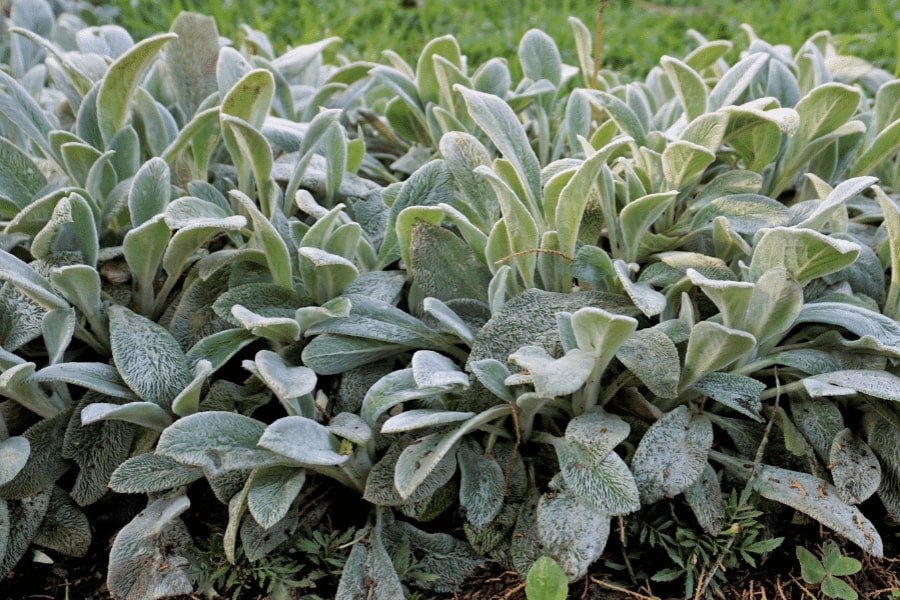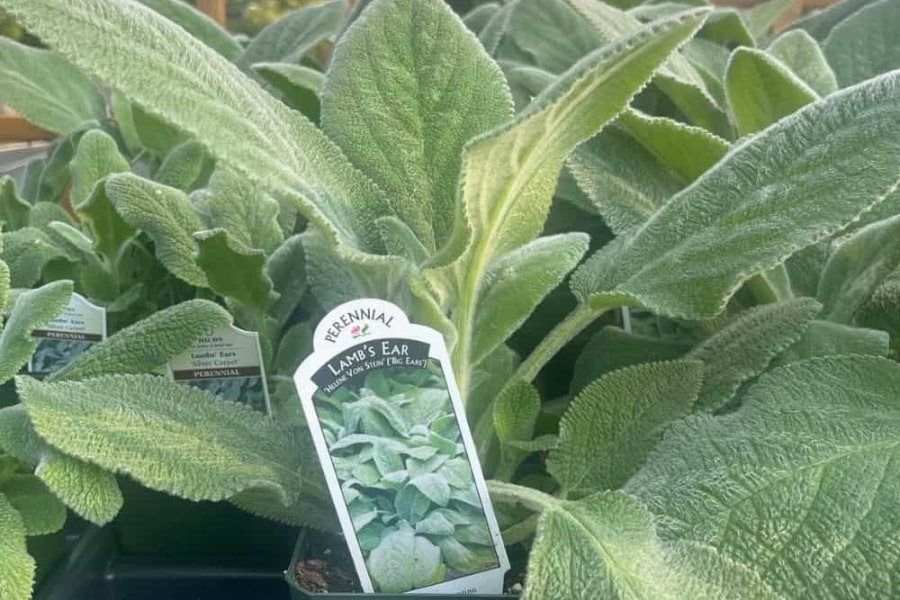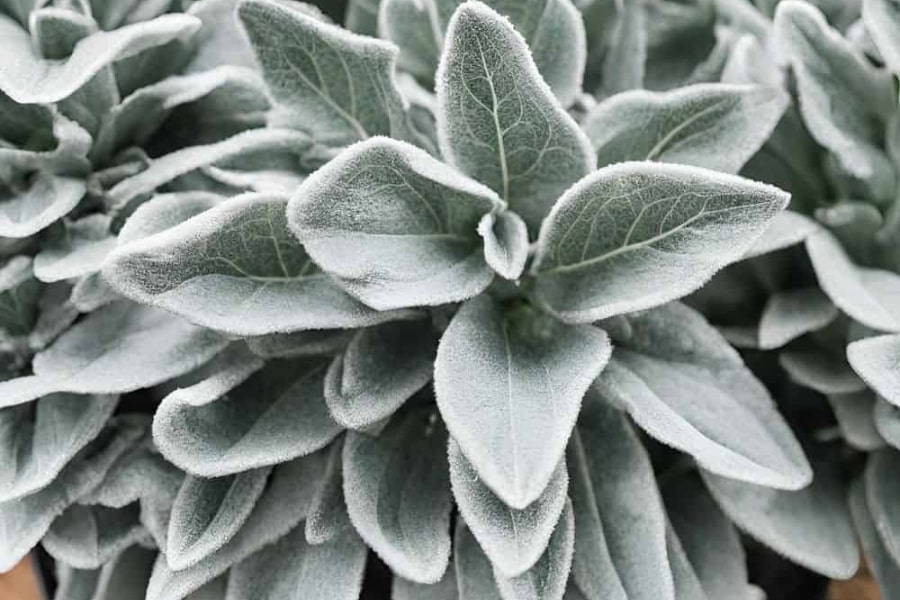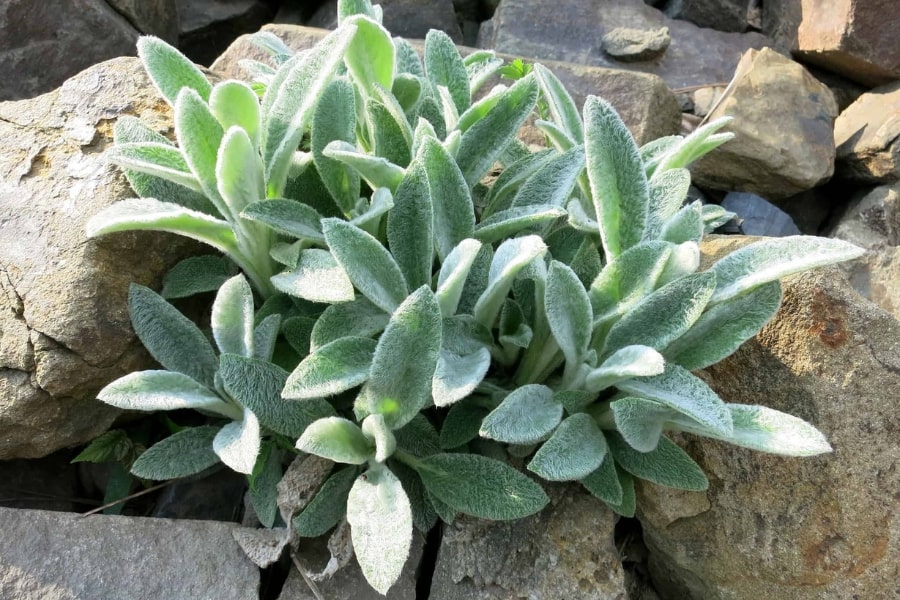Lamb’s Ear, also known as Stachys byzantina, is a popular perennial plant native to Turkey, Iran, and Armenia. It belongs to the mint family, Lamiaceae. Lamb’s Ear is known for its soft, velvety leaves, which give it a unique and attractive appearance. The plant typically grows in compact, low mounds, reaching a height of 12 to 18 inches. Its drought tolerance and ability to thrive in poor soils make it a favorite for rock gardens and borders.

Our Selection of Lambs Ear
This year, we are growing Stachys byzantina ‘Silver Carpet”. We also receive both Silver Carpet and the larger Helen Von Stein Lamb’s Ears in 4″ containers from our regional vendors to keep these plants stocked throughout the season.

Growing and Caring For Stachys
Lamb’s Ear is a hardy perennial that can withstand various climates, making it suitable for different regions. It is particularly well-adapted to USDA hardiness zones 4 to 8. The plant’s ability to endure hot and cold temperatures makes it an attractive choice for gardeners in diverse locations. Stachys may experience some dieback during winter in colder climates, but it generally rebounds in the spring, showcasing its resilience to temperature fluctuations.
One key factor for successful cultivation is sunlight. Lamb’s Ear thrives in well-drained soil and can tolerate a range of soil types, including sandy or loamy soils. However, it truly shines when exposed to full sunlight. Planting in an area that receives ample sunlight ensures the plant’s optimal growth, vibrant foliage color, and the production of its characteristic woolly leaves.
While Lamb’s Ear is known for its drought-resistant nature, adequate watering is crucial, especially during dry periods. Regular watering helps establish a strong root system in the initial stages of growth. However, striking a balance is essential, as Lamb’s Ear is susceptible to root rot in overly wet conditions. Well-draining soil is paramount to prevent waterlogged roots.
Regular maintenance, such as pruning, helps keep the plant tidy and encourages continuous growth. Removing spent flower spikes enhances the plant’s appearance and promotes a more robust and vibrant display. Fertilizing Stachys is a crucial aspect of maintaining the health and vibrancy of this versatile perennial. A balanced and well-timed fertilizer application during the spring can enhance the plant’s overall growth and appearance.
Leaves and Flowers
The leaves are the most captivating feature of Stachys, resembling a lamb’s ears. These leaves are silver-gray or green-gray and densely covered in fine, downy hairs that create a delightful texture, giving rise to the plant’s endearing nickname. These fuzzy leaves serve a functional purpose, helping the plant conserve moisture and protect it from excessive sunlight.
In addition to its eye-catching foliage, Stachys produces lovely flowers that emerge in upright spikes, rising above the foliage in elegant clusters. These spikes can reach varying heights, depending on the specific Stachys variety. The flower colors range from soft shades of pink and lavender to more vibrant purples and magenta. The individual flowers are tubular and often feature two lips, giving them a distinctive appearance. These charming blooms also attract pollinators like bees and butterflies.

Uses in the Garden
Lamb’s Ears are primarily used in gardens and landscapes as a groundcover or an edging plant. The soft, velvety leaves of Lamb’s Ears can provide a striking contrast to other plants in the garden, and the pink or purple flowers add a pop of color. Lamb’s Ears are also used in container gardens and can be grown indoors as a houseplant. These plants are also edible; the leaves can be used in salads or cooked like spinach. The leaves taste slightly bitter but are rich in calcium, potassium, and iron.

Frequently Asked Questions
Can You Smoke Lamb’s Ear Plant?
While Lamb’s Ear has been historically used for various purposes, smoking the plant is not a common or recommended practice. The plant does not contain any known psychoactive compounds that would make smoking it desirable for recreational or medicinal purposes.
How to Propagate Lamb’s Ear?
Lamb’s Ear (Stachys byzantina) can be easily propagated through several methods, including division, seeds, or stem cuttings.
- Division: Dig up a mature Lamb’s Ear plant and gently separate the root ball into smaller sections, ensuring each has roots and foliage. Replant the divided sections at the same depth as the original plant, spacing them according to the desired arrangement.
- Seeds: Collect seeds from mature Lamb’s Ear plants and sow them directly into well-prepared soil or in seed trays, pressing them lightly into the soil surface. Keep the soil consistently moist until germination occurs. Once the seedlings are large enough, transplant them to their permanent location.
- Stem Cuttings: Select healthy stems that are several inches long and cut the stems just below a leaf node. Remove the lower leaves to expose the nodes. Plant the cutting in a well-draining soil mix or directly in the garden. Keep the soil consistently moist until roots are established.
Do Deer Eat Lambs Ear?
Lamb’s Ear is known for its woolly, silver-gray foliage and velvety leaves, and it is generally considered to be deer-resistant. Deer tend to avoid plants with fuzzy or aromatic leaves, and the texture and scent of Lamb’s Ear make it less appealing to these animals.
